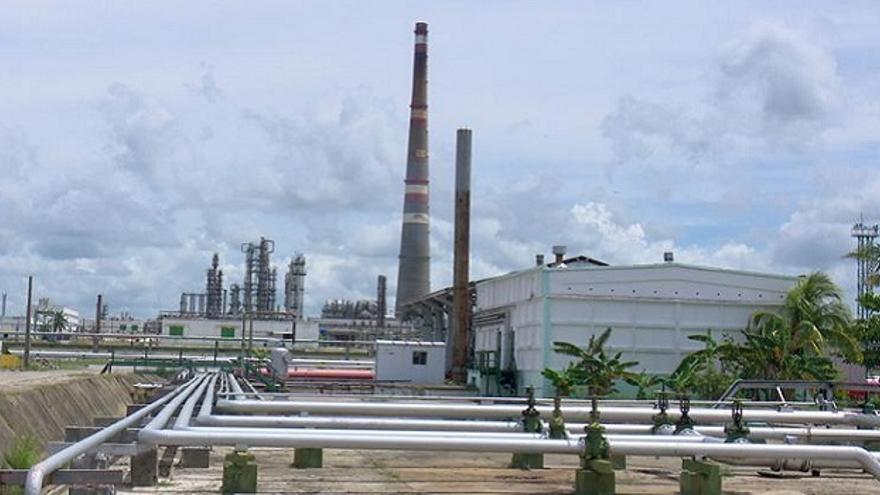
![]() 14ymedio, Havana, December 7, 2023 — The government of Cienfuegos has the province’s refinery to thank for more than 8.6 billion pesos in sales during the first half of 2023, 43.8% of all the money generated that year (about 20 billion). The data, one of the many that give the measure of the economic imbalance of Cienfuegos, appeared in the extensive accountability report that the provincial authorities published this Wednesday.
14ymedio, Havana, December 7, 2023 — The government of Cienfuegos has the province’s refinery to thank for more than 8.6 billion pesos in sales during the first half of 2023, 43.8% of all the money generated that year (about 20 billion). The data, one of the many that give the measure of the economic imbalance of Cienfuegos, appeared in the extensive accountability report that the provincial authorities published this Wednesday.
On the other hand, there was not a word about the 706,293 cubic feet per month of stone that the province uprooted from its El Cuero and Arriete quarries to send by boat for the 907 miles of ballast for the Maya Train, which will connect the main tourist cities of the Yucatan peninsula, in Mexico. It was a secret state agreement between the two leaders, Díaz-Canel and López Obrador, and the funds were sent directly to Havana.
The document covers all of 2022 and the first half of 2023. Dozens of meetings, hundreds of agreements and resolutions, and multiple debates demonstrate, according to the authorities, the seriousness of their work, even under two great challenges: blackouts and the “increase in political-ideological subversion.”
The refinery, subjected to repairs that ended last November, also led sales in 2022, when it was responsible for an even higher figure: of the 41,207 million pesos contributed by Cienfuegos to the State coffers, 24,284 million – 58% – came from the refinery.
Dozens of meetings, hundreds of agreements and resolutions, and multiple debates demonstrate, according to the authorities, the seriousness of their work
Despite the prominence of the factory, in whose port oil tankers with crude oil from Venezuela and Mexico dock, the provincial government refrains from offering other details on the subject in its report. “Without the refinery” – an expression that the text repeats to illustrate how bad the province would be if it did not have its services – the panorama is regrettable: from January to June, 27 state companies failed to meet the targets of their plans and delivered minimum profits.
The rest of the items are in the same situation: the province’s companies employ only 34,560 people, who recieve an average salary of 4,600 pesos per month. Between a rock and a hard place, the workers let the leaders know – and this is stated in the report – their problems: the deficit of inputs and raw materials, the breakage or lack of maintenance of the equipment, the poor quality of the tobacco in the province and the restrictions on the sale of the sugar that is manufactured (the government did not approve the sale of 5% of what was produced at a subsidized price, as the companies had requested).
As for the blackouts, the leaders said, the salvation was again the refinery: “The crude oil was productive,” they celebrated. Hence, the Carlos Manuel de Céspedes thermoelectric plant is “the most stable and efficient in the country.”
The strategy to get out of the debt hole?: “Charge” all the companies that owe them money
However, Cienfuegos owed the State 712,853 million pesos last June. The strategy to get out of the debt hole?: “Charge” all the companies that owe them money and think about what “potentialities” of the province can be exploited to oxygenate their income. In that plan, the police are a powerful ally: their “effectiveness” in the collection of fines – of 97.7%, they calculate – has recovered more than 1 billion pesos.
But the debacle of the province cannot be expressed only in numbers. The provincial government admits that it has received a barrage of requests, suggestions and complaints, although it does not have the means to resolve the situation. It is eloquent, for example, in the case of doctor’s offices. About 18 consultations must offer their services with “extended hours,” and patients do not stop complaining about the lack of “permanence of the doctor and the nurse.”
In the first half of this year, 11 children under age one died, which raised the infant mortality rate in the province to 8.3 per 1,000 live births. At the other end, it was detected that 9,641 elderly people in the province live alone. The so-called Grandparents’ Houses of several municipalities are already overflowing, and there is a lack of wheelchairs and hospital beds to guarantee a tolerable old age.
The situation of medicines is alarming: 196 are lacking, especially in hospitals where they are most used and in rural areas, where the distribution truck rarely arrives. The solution: to resort to “natural and traditional medicine,” whose plan targets, they say, are fulfilled by 105% in the cities and 143% in the countryside.
The authorities close the report with a detailed epigraph on “social illegalities and indisciplines,” in addition to supporting the police in “confronting crime and corruption.” The big problems, they say, are the “theft of livestock” and the illegal marketing of meat and other foods. In the crosshairs are Palmira and Rodas, two municipalities where criminals are active. But there is no need to worry, they emphasize, because soon there will be not only a “strengthening of investigations” but also an increase in the severity of convictions.
Translated by Regina Anavy
____________
COLLABORATE WITH OUR WORK: The 14ymedio team is committed to practicing serious journalism that reflects Cuba’s reality in all its depth. Thank you for joining us on this long journey. We invite you to continue supporting us by becoming a member of 14ymedio now. Together we can continue transforming journalism in Cuba.
